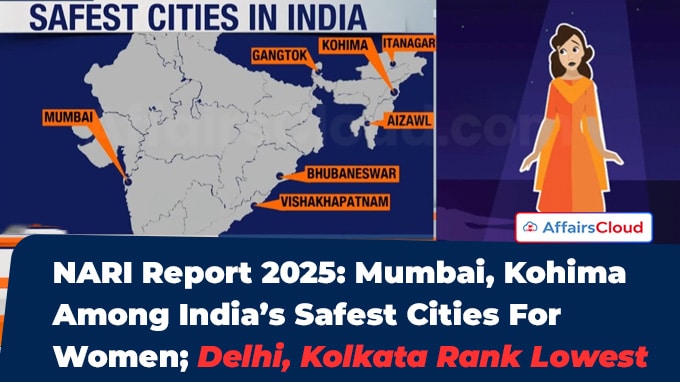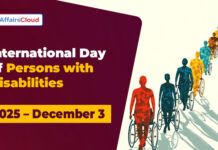 On 28 August 2025, the National Commission for Women (NCW) released the ‘National Annual Report and Index on Women’s Safety 2025 (NARI 2025)’. The report was launched by Vijaya Rahatkar, Chairperson of NCW.
On 28 August 2025, the National Commission for Women (NCW) released the ‘National Annual Report and Index on Women’s Safety 2025 (NARI 2025)’. The report was launched by Vijaya Rahatkar, Chairperson of NCW.
- According to NARI 2025, India has a 65% safety score, capturing women’s perceptions of safety, effectiveness of law enforcement, reporting mechanisms, and experiences in public spaces.
Exam Hints:
- What? Release of National Annual Report and Index on Women’s Safety (NARI 2025)
- Released By: Vijaya Rahatkar, Chairperson of NCW
- India’s Overall Safety Score: 65%
- Methodology: Survey of 12,770 women from 31 cities
- Publisher: Group of Intellectuals and Academicians (GIA)
- Top 3 Safest Cities : Kohima(Nagaland), Visakhapatnam(Andhra Pradesh, AP), Bhubaneswar(Odisha).
- Lowest-Safety Cities: Ranchi(Jharkhand), Srinagar, Jammu & Kashmir(J&K), Kolkata(West Bengal,WB)
About NARI 2025:
Methodology: The report is based on a survey of 12,770 women from 31 cities.
Survey Parameters: The survey assessed overall city safety, infrastructure, harassment incidence and reporting, domain-specific safety (neighbourhood, transport, education, work, health, recreation, online), and confidence in authorities, among other factors.
Categories: Cities have been grouped into four categories: “much above”, “above”, “below”, and “much below” the benchmark.
Purpose: The index not only ranks cities but also looks at how well local systems respond and what women actually experience in their daily lives.
Publisher: The 2025 NARI index is conceived by The NorthCap University and Jindal Global Law School and published by the Group of Intellectuals and Academicians (GIA).
Highlights of NARI 2025 :
Safest Cities for Women: As per the report, Kohima (Nagaland), Visakhapatnam (Andhra Pradesh, AP), and Bhubaneswar (Odisha) are the top scorers among the 7 cities that qualified as the safest for women.
- Aizawl(Mizoram) ranked 4th, stands out for its high social trust and safe urban culture.
- Gangtok(Sikkim, ranked 5th, is noted for strong community support and responsive policing.
- Itanagar (Arunachal Pradesh, AR) ranked 6th, helped by inclusive governance, awareness drives, and active role of women in local bodies.
- Mumbai (Maharashtra) ranked 7th, supported by proactive policing, safer transport, and strong workplace policies despite metro challenges
Least Safe Cities for Women: Ranchi (Jharkhand), Srinagar (Jammu & Kashmir, J&K) and Kolkata (West Bengal, WB) were among the cities ranked at the bottom of the NARI 2025 index.
- The NARI 2025 index also ranks Patna(Bihar); Jaipur(Rajasthan); Faridabad(Haryana); and New Delhi(Delhi) among the lowest in women’s safety.
- These cities were ranked at the bottom of the index, indicating the need for strengthened safety measures, awareness campaigns, and responsive governance to improve women’s safety.
Top 5 Safest Indian Cities for Women in 2025:
| Rank | City | State | Score | Reasons for Ranking |
|---|---|---|---|---|
| 1 | Kohima | Nagaland | 82.9% | Strong gender equity,and active public participation |
| 2 | Visakhapatnam | Andhra Pradesh, AP | 72.7% | Well-developed infrastructure and reliable policing |
| 3 | Bhubaneswar | Odisha | 70.9% | Good governance and planned urban facilities |
| 4 | Aizawl | Mizoram | 70.6% | High social trust, safe urban culture |
| 5 | Gangtok | Sikkim | 70.4% | Community support, responsive policing |
Least Safe Indian Cities for Women in 2025:
| Rank | City | State | Score |
|---|---|---|---|
| 1 | Ranchi | Jharkhand | 56.3% |
| 2 | Srinagar | Jammu & Kashmir, (J&K) | 58.1% |
| 3 | Kolkata | West Bengal(WB) | 58.2% |
| 4 | New Delhi | Delhi | 58.5% |
| 5 | Faridabad | Haryana | 58.7% |
Key Findings of NARI 2025:
Perception of safety: Among the women surveyed, about 60% feel safe in their city, while the remaining 40% do not. The gap shows that many women still lack confidence in their surroundings.
Day vs night safety: Most women felt reasonably secure during the day, but their sense of safety dropped sharply at night, especially in public transport, and in recreational spaces.
Harassment: In 2024, around 7% of women faced harassment , but the number was much higher (14%) among young women aged 18–24 years.
- Verbal harassment was the most common at 58%, while physical, psychological, economic, and sexual harassment occurred less frequently. The main hotspots were neighborhoods (38%) and transport (29%).
Workplace safety: A positive finding was that 91% of women felt safe at their workplaces.
Reporting of incidents: In response, 28% of women confronted harassers, 25% left the scene, 21% sought safety in crowds, and 20% reported incidents to authorities.
- The report stressed that two out of three women do not report harassment, pointing to gaps in trust and effectiveness of complaint systems.
About National Commission for Women (NCW) :
Chairperson – Vijaya Rahatkar
Headquarters – New Delhi, Delhi
Established – 1992




